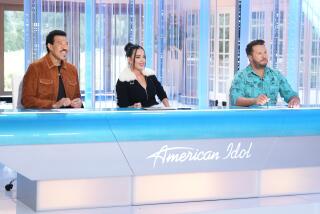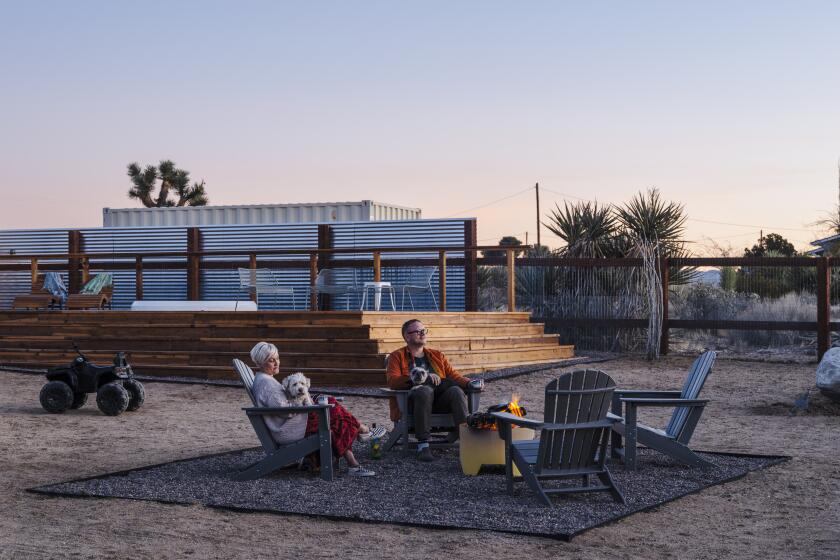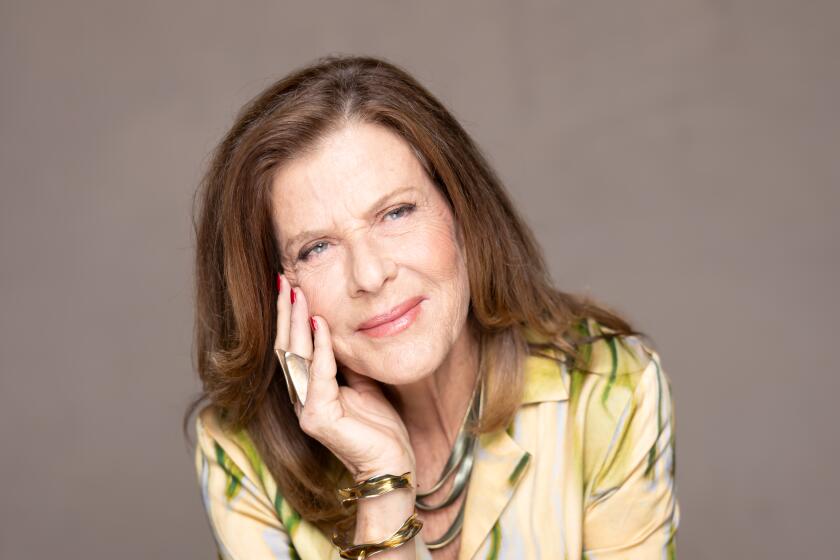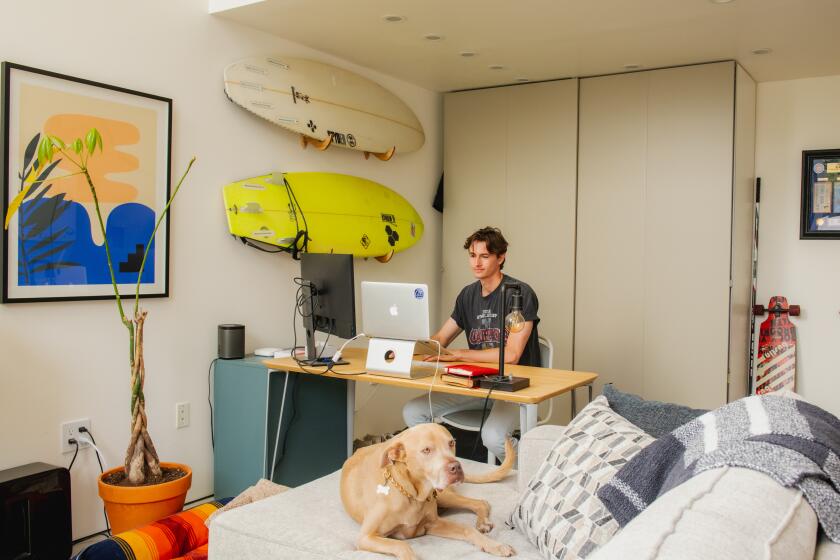Home of the Emmy : Academy of Television Arts & Sciences center draws crowds of fans, but has cut back on some of its grandiose ideas.
In 1991 the Academy of Television Arts & Sciences moved with considerable fanfare, including a mayoral proc lamation of “The Year of the Tele vision Academy,” into peach-colored permanent headquarters in North Hollywood.
The academy gave its name to a new 22-acre, $350-million entertainment and business complex at Lankershim and Magnolia boulevards, conceived by the Community Redevelopment Agency as the very heart of the revitalized NoHo district.
Today, the academy is a palpable presence in the East Valley. A 28-foot replica of the Emmy statuette dominates its TV Hall of Fame Plaza. Visitors come to gaze at the monumental gold-plated statue of the spirit of television, while enjoying the nearby fountain. Those truly smitten with television can stroll around the plaza among the bas-reliefs, statues and busts of inductees into the Hall of Fame, including such TV legends as Jack Benny, Lucille Ball, Carol Burnett and Bill Cosby.
The North Hollywood complex was the academy’s first permanent home and its most visible one. Since 1976, when it spun off from the New York-based National Academy of Television Arts & Sciences, the academy had existed more or less anonymously on floors of other people’s buildings, most recently rented seventh-floor space in a Burbank office building. Clearly, the academy is alive and well in its North Hollywood digs, putting together the prime-time Emmys and activities such as Wednesday’s fifth annual “Evening with Television Journalists.” But even as it has put on such highly successful programs as last year’s information superhighway summit, the academy has quietly trimmed back on some of the more ambitious and public plans it announced in 1991.
For instance, the academy originally hoped to raise $6 million to purchase the two-story building that houses its headquarters and to create a public-access library on the site. “For the time being, that has been abandoned,” said Murray Weissman, an academy member whose firm of Weissman/Angellotti does the academy’s public relations.
Instead, Weissman said, the academy is content to rent about 30,000 square feet of space for offices and other needs from the complex’s owner, KG Land Development Co., a Japanese firm. According to Weissman, the decision to rent rather than buy came about because the academy was able to get such a sweet deal from its landlord. The academy has a long-term lease (10 years with five 10-year options). It rents half the space for only $1 a year and the rest at competitive rates.
As part of the arrangement, the academy has free use of the complex’s highly regarded 600-seat theater for 90 events a year. The academy had originally announced its intention to buy the theater, but that too has been put on hold, Weissman said. As to the on-site library, that program has been canceled as well. Last fall, the academy turned its library materials over to USC (the academy’s archival collection of vintage television shows and other materials has been at UCLA since 1989).
“The academy felt that the material could better be preserved and handled through the university,” said Weissman, who pointed out that USC had both the funds and the expertise to make appropriate use of the materials.
The academy has also decided not to install 10 or 12 booths on the North Hollywood site where the public could view classic TV shows. According to Weissman, such facilities would duplicate those that will be available when the Museum of Television and Radio opens its new West Coast facility in Beverly Hills in a year or so. “Instead of being a copycat, the academy is staying with what it is,” he said.
The scaling back is largely a matter of economics, Weissman said. “There has been a recession,” he pointed out. “Unless you’re capable of doing something completely, in the right style and can afford it, it doesn’t make any sense to pursue it.”
The shift also reflects the decision of President Richard Frank and his advisers to concentrate the academy’s energies and resources on its core activities. These, Weissman said, include rewarding excellence in television broadcasting, providing programs and activities for the membership, providing educational programs for college students and others, maintaining and operating the Television Hall of Fame and publishing Emmy magazine and other publications. All these activities are based in North Hollywood, Weissman pointed out. The most visible of the academy’s activities is presenting the prime-time Emmys and co-presenting the daytime Emmys (with the National Academy). Fees for the right to broadcast the Emmy shows are the academy’s principal source of revenue.
*
Frank, who is chairman of Walt Disney Television and Telecommunications, became president of the academy in 1993 and, with the support of its 15-member executive committee and 50-member board of governors, he has put his own stamp on the institution, observers say.
According to Weissman, the Frank era has been marked by a new emphasis by the academy on telecommunications, a term that has replaced television in most academy materials except its official name. And James L. Loper, the academy’s executive director, notes that Frank’s tenure has also seen a dramatic increase in the number and quality of activities aimed at its 7,500 members. The academy is made up of 25 distinct “peer groups,” including actors, directors, producers, writers, crafts people and publicists. How-to programs for members (such as how to pitch a show) are now a regular feature of the academy calendar, Loper said.
Once a largely behind-the-scenes operation, the academy now schedules a couple of programs each month, at least half members-only. As Loper pointed out, about half the academy’s 7,500 members live in the Valley, and activities held at the North Hollywood complex are extremely convenient for them. But programs for the public are also part of the agenda.
Wednesday’s critics night, for instance, will feature Janice Kaplan of TV Guide, Jefferson Graham of USA Today and Los Angeles Times TV critic Howard Rosenberg, among others, airing their views on the current television season, from its violence to its ubiquitous infomercials. Other public programming penciled in for the coming year: the second annual Children’s Interactive Media Festival, tentatively scheduled for March 5; the annual preview of fall network and cable shows in July; a salute to TV Westerns, tentatively set for Aug. 10, and a conference on TV violence (date to be announced).
The academy is committed to North Hollywood, according to Weissman, and observers shouldn’t read too much into its recent decision to sanction a smaller-scale Television Hall of Fame Plaza at Disney-MGM Studios in Orlando, Fla. The academy is not about to bolt.
*
“It’s safe to say that the academy thought the whole redevelopment program was going to develop (in NoHo) faster than it has,” Weissman said. But the academy still has faith that “that the whole area is going to be built up”--the very factor that led it to choose the Lankershim-Magnolia site over the old Directors Guild building on Sunset and other suggested places.
Progress on Lankershim keeps moving north toward the academy, Weissman pointed out, and he is especially heartened by the growing likelihood of the North Hollywood Metro Rail station.
“With Metro Rail developing,” Weissman said, “the academy feels it’s in the perfect location.”
Evidence of its intent to stay: In April it will open a new conference center that can accommodate 150 people in the same building that houses the Academy Plaza Theatre.
Where and When
What: The fifth annual “Evening with Television Journalists,” a panel discussion sponsored by the Academy of Television Arts & Sciences.
Location: Academy Plaza Theatre, 5230 Lankershim Blvd., North Hollywood.
Hours: 7:30 p.m. Wednesday.
Price: $15 for non-members.
Call: (818) 754-2895.
More to Read
The biggest entertainment stories
Get our big stories about Hollywood, film, television, music, arts, culture and more right in your inbox as soon as they publish.
You may occasionally receive promotional content from the Los Angeles Times.






